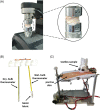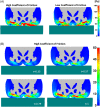Effects of humidity on skin friction against medical textiles as related to prevention of pressure injuries
- PMID: 29797409
- PMCID: PMC7949509
- DOI: 10.1111/iwj.12937
Effects of humidity on skin friction against medical textiles as related to prevention of pressure injuries
Abstract
Sustained pressure, shear forces, and friction, as well as elevated humidity/moisture, are decisive physical factors in the development of pressure injuries (PIs). To date, further research is needed in order to understand the influence of humidity and moisture on the coefficient of friction (COF) of skin against different types of medical textiles. The aim of this work was to investigate the effects of moisture caused by sweat, urine, or saline on the resulting COF of skin against different textiles used in the medical setting in the context of PI prevention. For that purpose, we performed physical measurements of static COFs of porcine skin followed by finite element (FE) computational modelling in order to illustrate the effect of increased COF at the skin on the resulting strains and stresses deep within the soft tissues of the buttocks. The COF of dry skin obtained for the 3 textiles varied between 0.59 (adult diaper) and 0.91 (polyurethane dressing). In addition, the COF increased with the added moisture in all of the tested cases. The results of the FE simulations further showed that increased COF results in elevated strain energy density and shear strain values in the skin and deeper tissues and, hence, in an increased risk for PI development. We conclude that moisture may accelerate PI formation by increasing the COF between the skin and the medical textile, regardless of the type of the liquid that is present. Hence, reduction of the wetness/moisture between the skin and fabrics in patients at a high risk of developing PIs is a key measure in PI prevention.
Keywords: computational modelling; finite element analysis; pressure injuries; skin friction.
© 2018 Medicalhelplines.com Inc and John Wiley & Sons Ltd.
Figures





References
-
- National Pressure Ulcer Advisory Panel . European pressure ulcer advisory panel and pan Pacific pressure injury alliance. In: Haesler E, ed. Prevention and Treatment of Pressure Ulcers: Quick Reference Guide. Perth, Australia: Cambridge Media; 2014.
-
- Campbell C, Parish LC. The decubitus ulcer: facts and controversies. Clin Dermatol. 2010;28(5):527‐532. - PubMed
-
- Levy A, Kopplin K, Gefen A. Device‐related pressure ulcers from a biomechanical perspective. J Tissue Viability. 2017;26(1):57‐68. - PubMed
-
- Sopher R, Gefen A. Effects of skin wrinkles, age and wetness on mechanical loads in the stratum corneum as related to skin lesions. Med Biol Eng Comput. 2011;49(1):97‐105. - PubMed
-
- Rotaru GM, Pille D, Lehmeier FK, et al. Friction between human skin and medical textiles for decubitus prevention. Tribol Int. 2013;65:91‐96.
MeSH terms
LinkOut - more resources
Full Text Sources
Other Literature Sources
Medical
Research Materials
Miscellaneous

